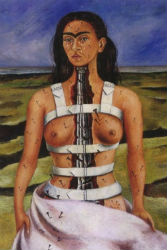Caspar David Friedrich
FROM ‘MARA, MARIETTA’
Intermezzo 6: Giulia
She asked me what I do for a living; I asked her if she liked Seedy Friedrich. ‘They’re my favourite band’, she replied. She was hip to the Twelfth Night quotation of An Apple Cleft in Twain, she was hip to the pun on Caspar David. It turned out she also loves the mysterious landscapes of the great German Romantic, the radical subjectivity of his lonely wanderer that Gram so ravishingly turns into song. And thus, my love, a moment of grace between your wanderer and a sister of mercy allowed me to believe I was more than a ghost.

Caspar David Friedrich, Wanderer above the Sea of Fog, 1818
JOSEPH LEO KOERNER ON CASPAR DAVID FRIEDRICH
Entering the Wood
From Joseph Leo Koerner, Caspar David Friedrich and the Subject of Landscape, 2nd Edition (London: Reaktion Books, 2009), pp. 189-197
Posted by kind permission of Joseph Leo Koerner
Mr. Koerner, among the foremost specialists in Northern Renaissance and 19th-century art, is Professor of the History of Art and Architecture at Harvard University.
He is also the writer and presenter of Northern Renaissance, an outstanding 3-part BBC Four series (2006).

Caspar David Friedrich, Early Snow, 1828
A path leads into the wood before me. I trace it with my eye: a white painted surface that rises vertically from the bottom of the canvas, but which, as I cling to it with my gaze, stretches forth as a horizontal path. I see into the canvas as if into a wood; my eye goes forth into this picture of an entrance as a stone would fall to earth. Entering the wood, my eye can trace many paths. Straight ahead, bare tree trunks give way to darkness. The wood I enter there appears like woodwork, or better, mock woodwork, like the false surface of a trompe-l’oeil. When the forest’s distance thus flattens into the canvas’s plane, depth and the illusion of entrance vanishes. If I raise my eyes higher, however, above the trees, my gaze can expand. The sky, a little patch of blue, invokes a vast space beyond the picture’s narrow horizons. Lowering my gaze, I can enter the wood, now confident of passage under the sky.
The path turns to the right and I follow it, yet it is a phantom path beyond what the painted image offers. To follow it is to trust myself to a ‘blind path’, yet it is precisely at this turn into blindness that Friedrich situates us in Early Snow. We know of such passages in real forests, roads that seem to lead somewhere but end in the unnavigable. These paths are paradoxes, since their existence means that someone was already there, yet their abrupt endings make us wonder where their first travellers have gone. In German such a path is called a Holzweg, which means both timber track and, figuratively, wrong track, as in being utterly at fault. Martin Heidegger saw in this double meaning a metaphor for thought and its itinerary. Every Holzweg leads off separately, but in the same forest, and ‘it seems often as if one is like the other. But it is only apparently so’. Like the foresters, the philosophers ‘know what it means to be on a Holzweg’. They know, that is, the geography of truth and error from within, and can bring us to the threshold of something never thought before. To pursue the Holzweg is to enter the new, although the new with obscure origins in the past.
Painted in 1828, the same year of the pendant canvases From the Dresden Heath, Friedrich’s Early Snow, now in Hamburg, is a picture of the new, of a world uncontaminated by a human gaze. The snow is untouched. I am the first to enter this wood; no footprints mar the uniqueness of my experience. My eyes dart about the canvas’s surface, drawn by the blank whiteness. My glance does not disturb the snow, but visits the scene with the snow, which recalls fortuitously the etymological link of ‘glance’ to ice (French glace), suggesting the sliding of the eye about this snowy scene. The snow withstands my gaze and the frozen scene, halted like myself in passage, remains present to me, its earliest discoverer. While the canvas was first exhibited in Dresden in 1828 under the title Spruce Forest in the Snow, it has acquired the appellation Frühschnee (‘Early Snow’), suggesting that this snow is the year’s first. Yet it could well be Frühlingsschnee, the last snow in a thawing world of spring. Art historians still argue over the season, just as Friedrich’s critics in 1809 were unsure about the time of day in Cross in the Mountains. But what is important is, of course, the uncertainty as to whether the scene is early or late.

Caspar David Friedrich, Spruce Thicket in the Snow (From the Dresden Heath I), 1828

Caspar David Friedrich, Easter Morning, 1828
Like so many of Friedrich’s landscapes, Early Snow fuses temporal extremes. The coming of winter may be the beginning of spring and the killing frost could just as well be a regenerative thaw. Friedrich assembles the old and the new in the picture’s vegetation: saplings rise above the snow in the foreground; behind them are older, larger trees until, in the background, the highest trees are red and dry with age. This notion of death combined with birth is developed by what is taken to be Early Snow’s pendant: the 1828 canvas entitled Easter Morning, now in Madrid. Repeating the Hamburg picture’s device of a road leading into the picture from the lower framing edge, Easter Morning stations three women in the foreground, recollecting the motif of the Three Marys traditional in scenes of Christ’s Resurrection. Read together, the two canvases would express an allegory of death and rebirth. Yet the play of life within death, of the early within the late, is already present in Friedrich’s Early Snow itself. Its landscape is of the fullness of the Augenblick which, as in the Verweile-doch of Goethe’s Faust, is the moment of ourselves. Standing before this painting, I am the first and the last to enter the wood.
About fourteen years before painting Early Snow, Friedrich finished another picture of virtually the same scene. Yet in Chasseur in the Forest, a traveller has entered the wood, halting before the turn in the path. His gaze penetrates the secret space that had been closed to our gaze in the snowy turn in Early Snow, and his presence radically alters the way we see the painted world before us. The dark figure draws attention to himself, arresting the movements of our eye about the canvas. The world looks altogether different with this traveller at its centre. Space organizes itself around him: it is no longer my lovely wood, my adventure in the snow, but his. The objects seem to desert me, showing themselves now to him. The trees in the foreground are not my companions, but have turned their shoulders to me as if to gaze at him; whatever is in the background has become his vision. I do not stand at the threshold where the scene opens up, but at the point of exclusion, where the world stands complete without me.
The temporal fabric of the wood has changed, as well. In Chasseur we oversee the experience of someone else, someone who was already there in a past long before our arrival. Where in Early Snow I had a sense of undisturbed presence, here I am not the first in this snowy landscape, for the traveller remains spatially and temporally before me. Nor am I the last. If I go forth into the painting’s space, seeking to stand where the turned traveller pauses, I will feel myself looked at from behind. Maurice Merleau-Ponty, following Karl Jaspers, reported that patients suffering from autoscopy (the hallucination of seeing oneself) feel the approach of their Doppelgänger through a burning sensation in the nape of the neck, as if someone were viewing them from behind. Autoscopy is somehow always implied by such turned travellers in Friedrich’s paintings, for in their faceless anonymity they mirror our act of looking in an uncanny way. During the experience of autoscopy, we read, ‘the subject is overcome by a feeling of profound sadness which spreads outwards and into the very image of the double.’ The sadness of seeing oneself seeing explains, perhaps, the melancholy colouring which a traveller gives to an empty landscape. Friedrich’s paintings are strangely sadder and lonelier when they are inhabited by a turned figure than when they are empty, Who is this sole self who halts before wandering into the painted world, and who, as Friedrich’s contemporaries interpreted Chasseur, hears his deathsong sung by the raven sitting in the margin that separates him from ourselves?

Caspar David Friedrich, Chasseur in the Forest, 1813-14

Jan van Eyck, Madonna of Chancellor Rolin, c. 1435
The Rückenfigur [figure seen from behind] is not Caspar David Friedrich’s invention, having a long if not quite coherent history in European painting before the nineteenth century. Already in Giotto turned figures sometimes feature in the foreground of a composition, establishing an imaginary fourth wall in the picture’s cube of space. These structuring bodies, though, rarely function strictly as viewers within the painted scene. And although Leon Battista Alberti in his treatise On Painting (1435-6) instructs artists to people their pictures with ‘someone who admonishes and points out to us what is happening there’, Italian pictorial practice favoured to this end figures gazing out of the picture at the viewer, rather than Rückenfiguren looking in. Early in the Northern tradition, Jan van Eyck used the Rückenfigur to advertise the extraordinary visual prospect realized through his craft. In the midground of the great Madonna of Chancellor Rolin, dating from around 1435 and now in the Louvre, a man peers over a battlement to behold a bustling town and mountainous landscape beyond, while his companion in a red turban (thought to be a self-portrait of the artist) looks on.
Confronted with a painting of unprecedented pictorial veracity, detail and scope, Jan van Eyck’s viewers discover their own attitude of visual amazement mirrored and thematized by these diminutive Rückenfiguren. With the further development of landscape painting in the sixteenth to eighteenth centuries, the Rückenfigur took its place within the stock repertoire of staffage which might ornament a panorama’s foreground and determine the overall character and message of the scene. In the ‘view-painting’ or veduta, a turned figure could establish the vista’s scale, enhancing its monumentality and marking off the whole pictorial field as something ‘worth seeing’. In one popular variant, the Rückenfiguren is an artist who sits at the margin of the scene, sketching the landscape we see. The draughtsmen at the right of a landscape etching of 1640 by the Dutch artist Allaert van Everdingen represent the operation of drawing from nature on which the print itself claims to be based.
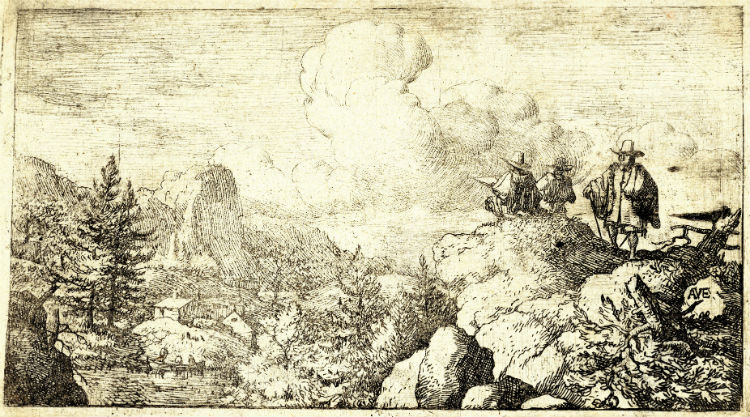
Allaert van Everdingen, The Draughtsman at the Rock, 1640
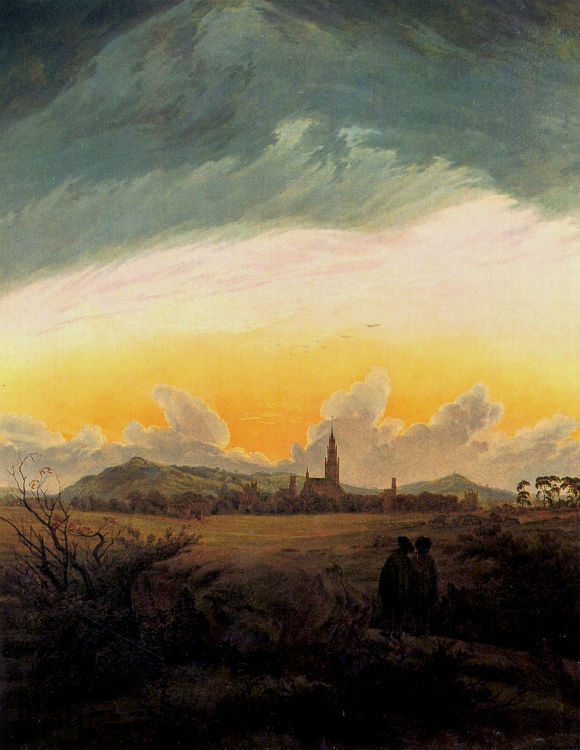
Caspar David Friedrich, Neubrandenburg, 1817
Friedrich’s Rückenfiguren are perhaps closest to this conceit, although the event they dramatize is never the actual labour of making, but rather the originary act of experience itself. Appearing alone, in symmetrical pairs, or in groups contemplating a sublime view they dominate the natural scene with their presence, defining landscape as primarily the encounter of subject with world. They are the ubiquitous, almost obsessive, signatures of Friedrich’s Erlebniskunst. In Chasseur in the Forest, it is true, the Rückenfigur conveys a very specific message, as well. Dressed in the uniform of the Napoleonic cavalry, the horseless chasseur in the German forest stands for the French foe vanquished in the wars of liberation. In this Rückenfigur’s solitude, as well as in the assembled signs of his impending death, Friedrich does not simply mourn the human condition, but also celebrates Germany’s military victory. Usually, however, such turned figures are not foes but reflective foils of both artist and viewer, figures, that is, of the subject in the landscape. As such, they have a far more totalizing tenor that sets them apart from the marginal staffage that ornamented earlier landscape art.

Caspar David Friedrich, Evening, 1821

Caspar David Friedrich, Two Men by the Sea, 1817

Friedrich, Flatlands on the Bay of Greifswald, c. 1832
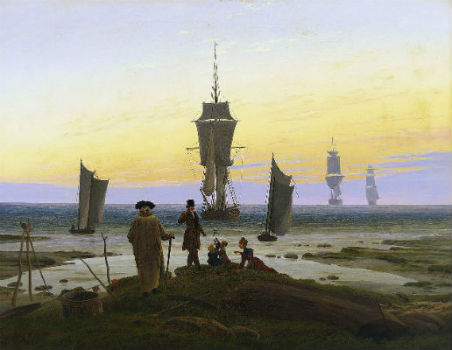
Friedrich, The Stages of Life, c. 1835

Friedrich, Moonrise at Sea, c. 1821
This change is clear if we compare Friedrich’s Rückenfigur to similar devices within the Baroque emblem tradition. Art historians have long noted the striking similarities between some of Friedrich’s landscapes and Jan Luiken’s illustrations for Christophoro Weigelio’s popular emblem book, Ethica Naturalis (1700). In Luiken, the human figure dominates the landscape. Indeed he seems to exist in a separate space, rather like an actor before a stage setting. He does not claim to ‘experience’ the scene, the landscape being only a book which he reads and interprets. Often Luiken’s figures will gesture towards the scene, as if to say, ‘Behold!’ They are not concerned with the beauty of the landscape, but with its public and usually, moral significance, which they mediate in the texts appearing around the image.

Jan Luiken, Iris (Illustration from Christophoro Weigelio, Ethica Naturalis) 1700

Caspar David Friedrich, Mountain Landscape with Rainbow, c. 1810
In Friedrich’s Mountain Landscape with Rainbow, the landscape has grown and the Rückenfigur has fallen silent. What he mediates is not a meaning, but an experience of the full presence of landscape. This landscape may have, like the face of the halted traveller, more to it than meets the eye, yet this ‘more’ is closed to us, a private inscription carried by the wanderer whose experience we only oversee. As if to indicate the personal dimension, Friedrich has fashioned the Rückenfigur as a portrait of himself, reoccupying but transforming the old motif of the artist sketching in the landscape.
Friedrich represents himself several times as Rückenfigur. Occasionally, and more hauntingly, he observes his own family from behind, as in his masterpiece, Evening Star, dating from around 1834 and now in Frankfurt. Against a sublime evening sky, with the silhouette of Dresden’s church recognizable on the horizon, Friedrich depicts what probably are his wife and children walking homewards: to the left, Caroline née Bommer, whom Friedrich married in 1818; by her side one of the couple’s daughters, either Emma (b. 1819) or Agnes Adelheid (b. 1823); and at the crest of a small rising, with his arms raised as if to greet the immensity of the view, or to grasp the veering bands of clouds above, their youngest child and only son Gustav Adolf (b. 1824). The boy’s gesture is unusually animated, for Friedrich typically pictures subjects frozen in contemplation, their stillness a mark of an immense interiority. It is as if, through the gesture of his son, Friedrich were trying to capture the entire afflatus of experience in a single gesture, or as if, from the perspective of a boy, nature’s engulfing infinity can be wrested down to earth. And the world responds. For if we block out the child from the picture, observing the scene peopled only by the mother and daughter at the left, the bands of clouds and sky appears to rise higher above the land. Friedrich’s son as Rückenfigur draws down to earth the evening sky, as if for a moment catching the departing light in the coincidence of his open arms and the edge of the horizon’s darkening bank of clouds.
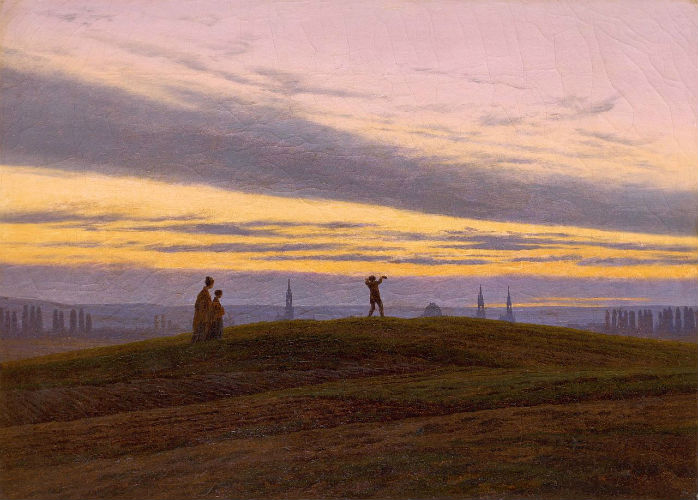
Caspar David Friedrich, Evening Star, 1830-35

Caspar David Friedrich, Cross in the Mountains (Tetschen Altar), 1808
Friedrich observes his family’s homecoming from afar, expressing poignantly what we know of the artist’s personal stance in later life. After his initial success with Cross in the Mountains, and following a period of critical acclaim and financial stability between 1810 and about 1820, Friedrich’s star began to fade, his art overshadowed by new directions in landscape; the Nazarene painters in Vienna and Rome, the ‘heroic’ landscape of Joseph Anton Koch and Ludwig Richter, and the naturalism of the Düsseldorf School. Having failed to secure a regular professorship at the Dresden Academy, and with ever fewer patrons, Friedrich grew embittered, self-pitying and distrustful of his friends, turning even against his wife, whom he suspected (wrongly, Carus informs us) of sexual infidelities. In June 1835 he suffered a stroke which left him debilitated until his death in 1840. Executed just before 1835, Evening Star reads as one of his innumerable ‘last testaments’ from the period (this is, after all, the artist who still in his early thirties fantasized his own funeral in an 1804 sepia). On the last hill that shows him all his valley, Friedrich turns and stops and lingers, before, like his Rückenfiguren, he forever takes his leave.

Joseph Leo Koerner, The Moment of Self-Portraiture
in German Renaissance Art

Joseph Leo Koerner, Caspar David Friedrich
and the Subject of Landscape

Joseph Leo Koerner, Bosch & Bruegel:
From Enemy Painting to Everyday Life























